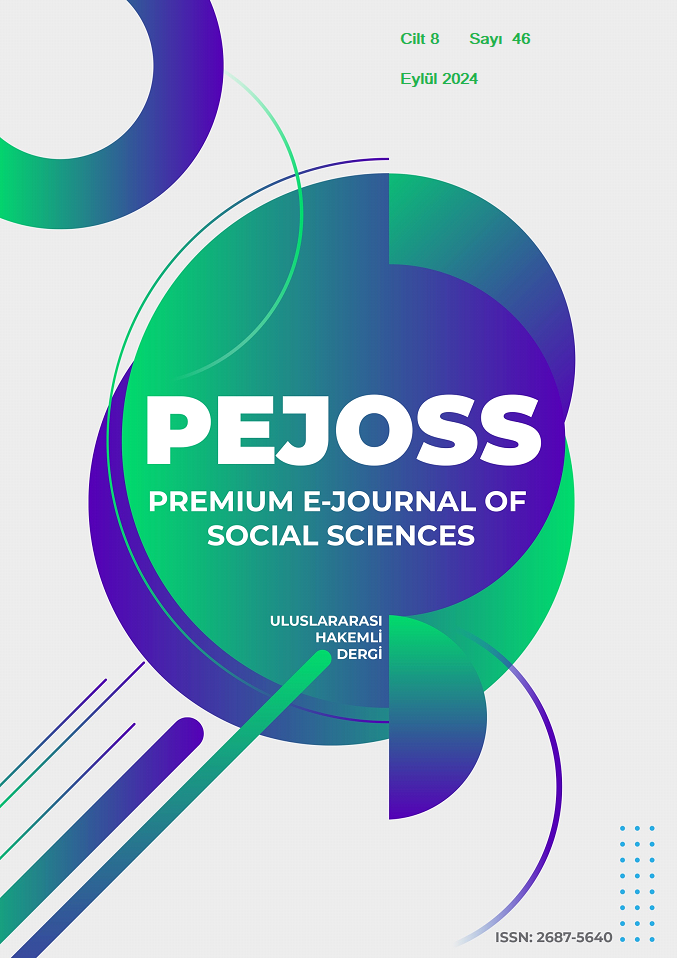The Nexus Among Financial Development and Youth Unemployment: An Empirical Approach
DOI:
https://doi.org/10.5281/zenodo.13881605Keywords:
Financial development, Youth unemployment, ARDLAbstract
The employment of individuals is a very important issue for both the individual and society. It is therefore essential that those who are actively engaged in the workforce are guaranteed the opportunity to participate in the labor market, thereby preventing the formation of social classes and divisions. Young people, who are the guarantee of the future of a country, are among the most vulnerable groups in terms of labor employment. This situation increases the importance of youth unemployment. In a context of accelerated globalization, financial developments that enhance output, production, and consumption play a pivotal role in the economic and social advancement of nations. Therefore, the aim of this study is to reveal the nexus between financial development and youth unemployment in the Türkiye's sample. Due to data limitations, the study covers the period from 1988 to 2021. The findings of the study, which employed the ARDL method, indicate that financial development has a significant negative impact on youth unemployment during the specified period.
Downloads
References
Acemoglu, D. (2001). Credit market imperfections and persistent unemployment. European Economic Review, 45(4-6), 665–679.
Açdoyuran, B., & Kılıç, N. Ö. (2018). BRICS ülkelerinde finansal gelişme ve büyüme ilişkisi: Panel veri analizi. IKSAD II – International Conference on Social Sciences. 1109–1124.
Afonso, A., & Blanco-Arana, M. C. (2023). Unemployment and financial development: evidence for OECD countries. Comparative Economic Studies, 1–23.
Arco-Tirado, J. L., Fernández-Martín, F. D., & Jagannathan, R. (2021). No jobs, no hope: The future of youth employment in Spain. In The growing challenge of youth unemployment in Europe and America (pp. 51–78). Bristol University Press.
Ayadi, R., Naceur, S. B., & Goaied, M. (2019). Financial Development and Employment: New Evidence (No. 25). EMNES Working Paper.
Bbaale, E. (2014). Where are the Ugandan youth: Socio-economic characteristics and implications for youth employment in Uganda. Journal of Politics and Law, 7(1), 37–63.
Chen, T. C., Kim, D. H., & Lin, S. C. (2021). Nonlinearity in the effects of financial development and financial structure on unemployment. Economic Systems, 45(1), 1–17, 100766.
Chen, T. C., Kim, D. H., & Lin, S. C. (2021). Nonlinearity in the effects of financial development and financial structure on unemployment. Economic Systems, 45(1), 100–766.
Dao, M. C., & Liu, L. Q. (2017). Finance and employment in developing countries: The working capital channel. International Monetary Fund.
Dickey, D., & Fuller, W. (1981). Likelihood ratio statistics for autoregressive time series with a unit root. Econometrica, 49(4), 1057–1072.
Emekaraonye, C. F., Madubuike, K. O., Onuoha, F. C., & Mbadiwe, M. M. (2023). Reduction of youth unemployment through rural banks' credit: New empirical evidence in Nigeria. Evangel International Journal of Arts and Social Sciences, 3(2), 38–48.
Ezekoye, B. N. (2014). Youth self-employment and the emerging software development industry. Tackling Youth Unemployment, 367–383.
Fatokun, D. I., Folarin, E. M., & Agbawn, M. O. (2023). Impact of credit to private sector on youth unemployment rates in Nigeria (1991-2021). International Conference on Africa’s Sustainable Development (ICASUD) 2023.
Fitzenberger, B., Gürtzgen, N., & Pfeiffer, F. (Eds.). (2015). Determinants and Economic Consequences of Youth Unemployment at the Beginning of the 21st Century. Lucius & Lucius.
Franz, W. (1982). “Youth unemployment in the Federal Republic of Germany: Theory, empirical results, and policy implications: An economic analysis”. ISBN: 3-16-344583-7, J.C.B. Mohr.
Gatti, D., Rault, C., & Vaubourg, A. G. (2012). Unemployment and finance: how do financial and labour market factors interact? Oxford Economic Papers, 64(3), 464–489.
Hajdu, J. (2014). Legal Protection of Unemployed Young People in Europe. Tackling Youth Unemployment, 27–55.
ILO, (2022). Global employment trends for youth 2022: Investing in transforming futures for young people. https://doi.org/10.54394/QSMU1809
Kanberoğlu, Z. (2014). Finansal sektör gelişimi ve işsizlik: Türkiye örneği. Ekonomik ve Sosyal Araştırmalar Dergisi, 83–93.
Kim, D. H., Chen, T. C., & Lin, S. C. (2019). Finance and unemployment: New panel evidence. Journal of Economic Policy Reform, 22(4), 307–324.
Mills, M., & Blossfeld, H. P. (2006). Globalization, uncertainty and the early life course: A theoretical framework 1. In H. P. Blossfeld, E. Klijzing & M. Mills (Eds.), Globalization, uncertainty and youth in society (pp. 1–23). Routledge.
Pagano, M., & Pica, G. (2012). Finance and employment. Economic Policy, 27(69), 5–55.
Pesaran, M. H., Shin, Y., & Smith, R. J. (2001). Bounds testing approaches to the analysis of level relationships. Journal of Applied Econometrics, 16(3), 289–326.
Phillips, P., & Peron, P. (1988). Testing for a unit root in time series regressions. Biometrika, 75(2), 335–346.
Raifu, I. A., Kumeka, T. T., & Aminu, A. (2024). Financial development and unemployment in MENA: Evidence from heterogeneous panel causality and quantile via moment regression. Journal of the Knowledge Economy, 15(1), 3512–3550.
Rakauskienė, O. G., & Ranceva, O. (2014). Youth unemployment and emigration trends. Intellectual Economics, 8(1), 165–177.
Wasmer, E., & Weil, P. (2004). The macroeconomics of labor and credit market imperfections. American Economic Review. 94, 944–963.
Downloads
Published
How to Cite
Issue
Section
License
Copyright (c) 2024 Premium e-Journal of Social Science (PEJOSS)

This work is licensed under a Creative Commons Attribution 4.0 International License.


